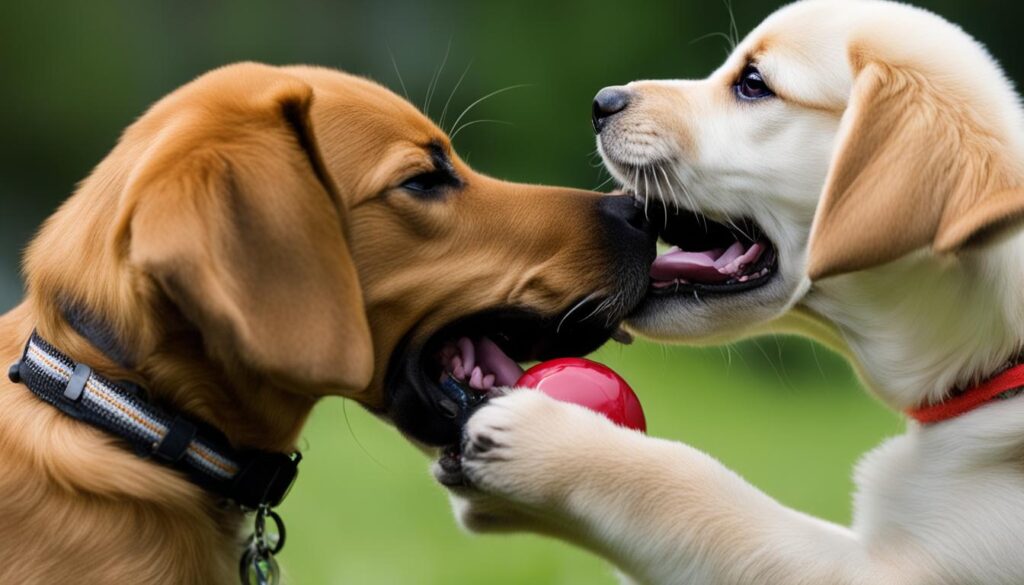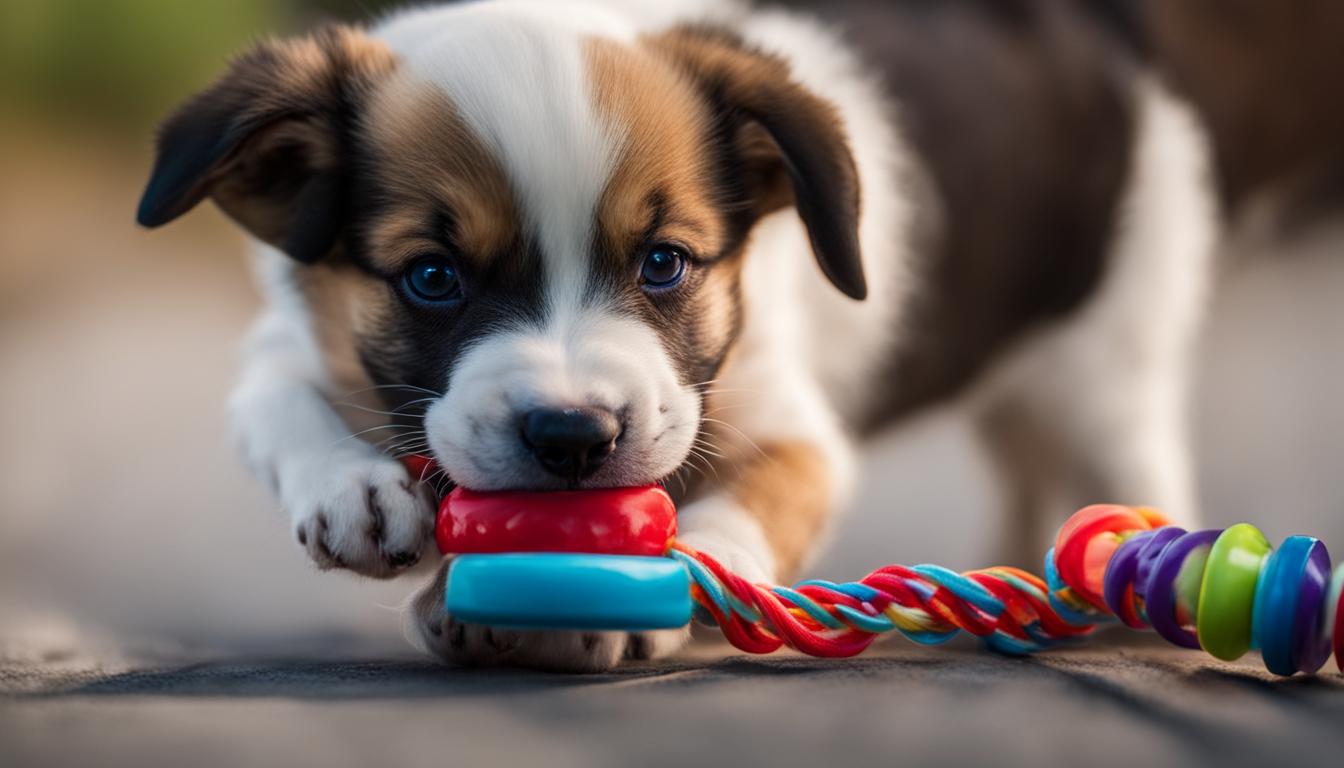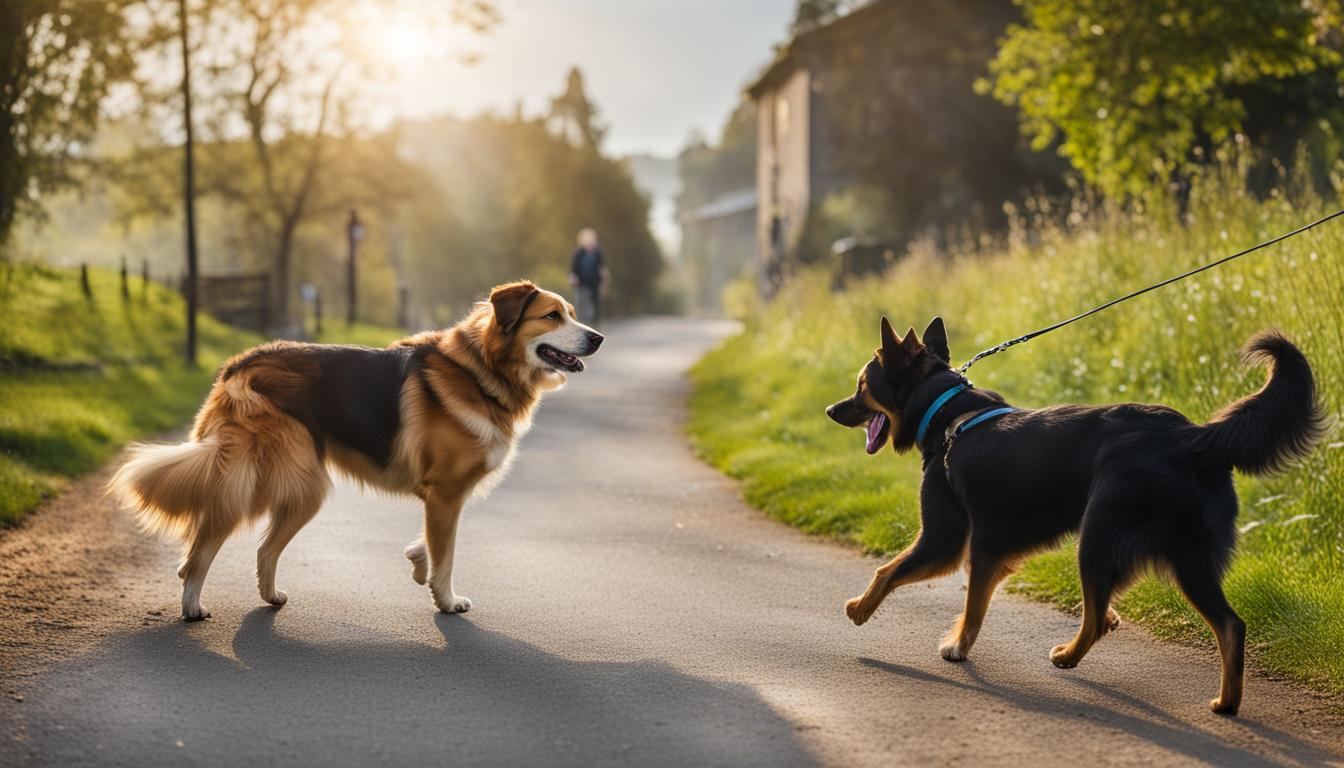Welcome to our comprehensive guide on curbing biting behavior in puppies. If you’re a new puppy parent, you may have already experienced those sharp little teeth on your hands or ankles. Don’t worry, it’s completely normal! Puppies bite as a way to explore and interact with their environment. However, it is essential to teach them proper bite inhibition to prevent potential issues in the future.
Understanding why puppies bite is the first step in addressing this behavior. In this section, we will explore techniques backed by research to help you train your puppy and manage their biting tendencies effectively.
Key Takeaways:
- Proper techniques can help address and reduce puppy biting behavior.
- Puppy biting is a normal behavior that typically lasts 3-6 months.
- Adequate exercise, training sessions, and socialization are important in curbing biting tendencies.
- Teaching “leave it” and using positive reinforcement with “yes” and “no” cues can be effective strategies.
- Consistency and patience are key when training puppies to reduce biting.
The Importance of Adequate Exercise in Curbing Biting Behavior
Biting is a common behavior in puppies, but it can be managed effectively through proper training techniques. One essential aspect of addressing biting behavior is ensuring that your puppy receives adequate exercise. Regular exercise not only helps your puppy release their energy but also promotes their overall physical and mental well-being.
When it comes to exercise, it’s important to consider your puppy’s breed and age. As a general guideline, providing five minutes of exercise per month of age, twice a day, is recommended. This means that if your puppy is three months old, they should receive 15 minutes of exercise two times a day.
Structured games such as fetch, tug-of-war, and using a flirt pole are excellent ways to engage your puppy in physical activity. These activities provide mental stimulation and help tire out your puppy, reducing their inclination to bite out of boredom or excess energy. Remember to monitor your puppy’s exercise level and consult with your veterinarian to determine the appropriate amount and intensity for their specific needs.
“Regular exercise not only helps your puppy release their energy but also promotes their overall physical and mental well-being.”
In addition to physical exercise, mental stimulation is equally important in managing biting behavior. Engaging your puppy in training exercises specifically designed to address biting issues can help redirect their energy and focus. Incorporate obedience training sessions into your daily routine, teaching your puppy basic commands such as “sit,” “stay,” and “leave it.”
By providing your puppy with adequate exercise and mental stimulation, you can significantly reduce biting behavior and create a harmonious environment for both you and your furry friend. Remember to be patient and consistent in your training efforts, as it takes time for puppies to learn and adapt to new behaviors.

Teaching Leave It as a Key Technique to Manage Biting
Biting is a normal behavior in puppies, but it’s essential to address it early on to prevent any negative habits from forming. One effective technique in managing biting behavior is teaching your puppy the “leave it” command. This command teaches your puppy to restrain from biting or mouthing objects when instructed to do so.
To teach your puppy “leave it,” start by attracting their attention with a treat in your closed hand. As your puppy tries to sniff or nibble at your hand, say “leave it” in a firm yet calm tone. When they stop trying to access the treat, praise them and offer them a different, more appropriate toy or treat. Repeat this exercise regularly, gradually increasing the difficulty by using more enticing objects or introducing distractions.
Positive reinforcement is key when teaching “leave it” to your puppy. Reward them with treats and praise each time they successfully comply with the command. This helps them associate the behavior of not biting with positive outcomes. Consistency and patience are crucial, as it may take time for your puppy to fully grasp and apply the “leave it” command in different situations.
“The ‘leave it’ command is an invaluable tool in managing biting behavior. By teaching your puppy what is off-limits, you are fostering bite inhibition and promoting appropriate mouth manners. Remember to always reward good behavior and redirect their attention when necessary.”
Teaching Leave It: Step-by-Step Guide
- Show your closed hand with a treat inside to your puppy.
- When your puppy tries to bite or sniff your hand, say “leave it” firmly.
- Once your puppy stops trying to access the treat, praise them and offer them an appropriate toy or treat.
- Repeat the exercise, gradually increasing the difficulty and introducing distractions.
- Reward your puppy with treats and praise each time they successfully comply with the command.
- Practice consistently to reinforce the behavior and help your puppy generalize the command.
By using positive reinforcement and consistent training, you can effectively manage your puppy’s biting behavior and promote healthy mouth habits. Teaching the “leave it” command not only helps prevent unwanted nipping and biting but also fosters a strong bond between you and your furry friend.
| Benefits of Teaching “Leave It” | Benefits of Positive Reinforcement |
|---|---|
|
|

Remember, it’s important to consult with a professional dog trainer if your puppy’s biting behavior is severe or aggressive. They can provide guidance tailored to your puppy’s specific needs and help you address the issue effectively.
Teaching “Yes” and “No” for Effective Puppy Training
When it comes to addressing biting behavior in puppies, positive reinforcement plays a crucial role. Teaching your puppy the meaning of “yes” and “no” can help them understand appropriate behavior and reduce biting. By rewarding positive behaviors with a “yes” and treats, and redirecting or withholding rewards for unwanted behaviors, you can reinforce the desired conduct.
Using positive reinforcement techniques, such as treats, praise, and petting, can create a strong association between good behavior and positive outcomes. For example, when your puppy responds appropriately to a command or refrains from biting, say “yes” enthusiastically and offer them a treat. This helps your puppy differentiate between acceptable and unacceptable actions, including biting. Consistency and repetition are key in teaching your puppy these cues.
Additionally, it is important to redirect your puppy’s biting behavior and provide appropriate chewing alternatives. When your puppy bites, firmly say “no” and immediately replace your hand or the object they were biting with a chew toy or bone. This teaches them that biting human skin or objects is not acceptable, and redirects their attention to a more appropriate outlet for their chewing needs.
“Teaching a puppy the meaning of ‘yes’ and ‘no’ is essential for their development and understanding of proper behavior. By using positive reinforcement techniques and redirecting their biting behavior, we can guide them towards becoming well-mannered adult dogs.” – Dr. Sarah Thompson, Canine Behavior Expert
Benefits of Positive Reinforcement
Positive reinforcement not only helps in curbing biting behavior but also strengthens the bond between you and your furry friend. By focusing on rewarding desirable behaviors instead of punishing unwanted ones, you create a positive and enjoyable learning experience for your puppy. Positive reinforcement is a humane and effective training method that encourages your puppy to make the right choices through motivation and encouragement.
By using positive reinforcement techniques, you can instill confidence in your puppy and create a harmonious environment for both of you. Remember, patience and consistency are key when training your puppy. With time and proper training, your puppy can learn bite inhibition and develop into a well-mannered adult dog.

| Benefits of Positive Reinforcement | Benefits of Redirecting Biting Behavior |
|---|---|
|
|
Conclusion
Puppy biting is a common behavior that can be managed and reduced with the right techniques. By implementing proper training methods and understanding your puppy’s needs, you can address both teething and aggressive biting in puppies.
One important aspect of managing puppy biting is socialization. Introducing your puppy to other dogs and providing opportunities for positive interactions can help them learn appropriate behavior and reduce biting tendencies. Socialization also helps puppies develop confidence and good manners.
Additionally, understanding the teething process is crucial. Puppies go through a stage where they chew and nip to relieve teething discomfort. Providing appropriate chew toys and redirecting their biting behavior towards these toys can help alleviate teething discomfort and prevent them from biting inappropriate objects or people.
If you’re facing challenges with severe or aggressive biting behavior, don’t hesitate to seek assistance from a professional dog trainer. They can provide guidance tailored to your puppy’s specific needs and help you establish a training plan to address the issue effectively.
FAQ
Why do puppies bite?
Puppies bite as a way to explore and interact with their surroundings. It is a normal behavior.
How long does puppy biting last?
Puppy biting usually lasts about 3-6 months, but the duration can vary.
How can I stop my puppy from biting?
Adequate exercise, training sessions, teaching “leave it” and “yes” and “no,” and socialization with other dogs are some effective ways to stop puppy biting.
How can exercise help reduce biting behavior?
Exercising your puppy is one of the best ways to reduce biting behavior. It helps release their energy and provides mental stimulation.
How do I teach my puppy the “leave it” command?
To teach the “leave it” command, you can attract your puppy’s attention with a treat and then close your hand to prevent access. Positive reinforcement and practice with various objects and distractions can help them learn.
How can I use positive reinforcement to address biting?
By teaching your puppy the meaning of “yes” and “no” and rewarding positive behaviors, you can help them understand appropriate behavior and reduce biting.
What should I do if my puppy’s biting behavior is severe or aggressive?
If you are struggling with severe or aggressive biting behavior, it is recommended to seek help from a professional dog trainer.
How long does it take to train a puppy to stop biting?
Training times can vary, but with patience, consistency, and proper techniques, puppies can learn bite inhibition and develop into well-mannered adult dogs.





